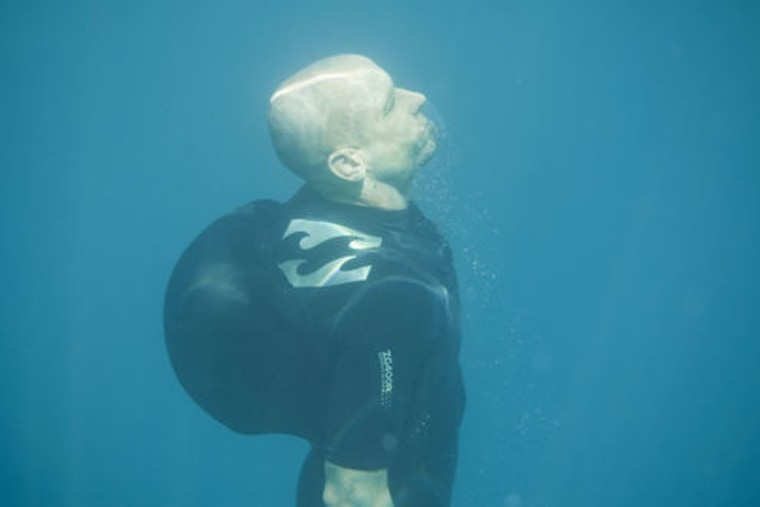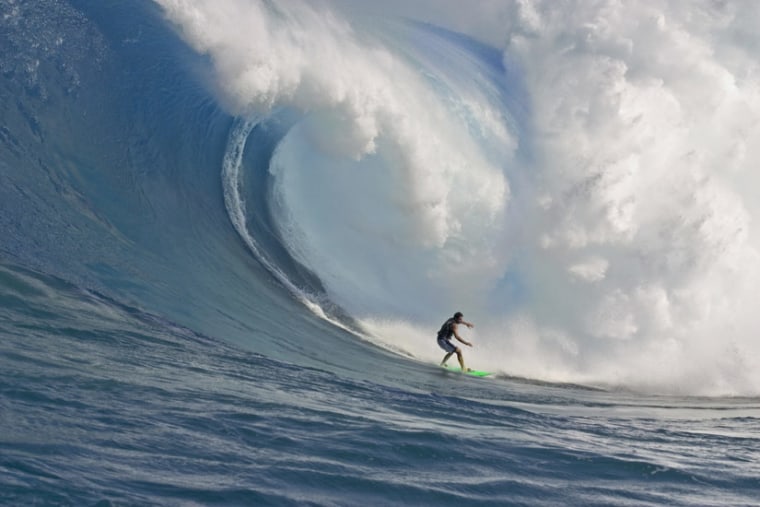It was the worst wipeout of surfer Shane Dorian's life.
Soon after he dropped into a monster wave at Maverick's, south of San Francisco last February, the wave changed shape and Dorian hurtled into the bottom of a 50-foot curling face, just ahead of a wall of crashing whitewater. The swell engulfed him, pinned him under, and held him there. Still underwater, the next wave rolled over him and slammed him some more.
Surfers call that a "double hold-down," and the accident nearly drowned him. When Dorian finally emerged from the foam, he was rattled, nauseous and experiencing symptoms of a concussion. He was also struck by inspiration.

"I had an idea to incorporate an air bladder, just like the airplane one where you go 'poof' and it inflates immediately," Dorian said in an interview for a Billabong video. "So I wrote an e-mail to Hub, who is the wetsuit designer at Billabong. And I told him my idea."
A year later, the idea, an instantly inflatable wetsuit for big-wave surfers, is now reality and in its prototype stage, said Hub Hubbard, wetsuit product manager at Billabong USA in Irvine, Calif. He has created six of the wetsuits so far.
The concept is simple. Using wetsuit material, Hubbard creates a zippered pouch that he sews onto the back of the wetsuit between the shoulder blades. A palm-sized carbon-dioxide cartridge screws into a durable bladder. The whole thing fits into the pouch.
A cord then hangs over the surfer's shoulder. Pulling it releases compressed air, filling up the bladder instantly. Deflated, the bladder looks like a small lump on the back of the wetsuit. Blown up, it's about the size of a surfer's head.
"If you get in trouble, you pull the cord just like a parachute," Hubbard said. "It's the same thing on instantly inflatable lifeboats, jackets that you get on airplanes and paintball guns."
The bladders, which were created by the Mustang Survival Corp. for use by the United States military, are reusable for up to five years, Hubbard said. Cartridges are single-use, but they screw on and off, making them easy to replace on a boat between wave sets.
Dorian has tested the wetsuit in calm waters and has even used it to surface quickly after wipeouts in big waves. His most recent activation of the bladder came in March after he paddled into a record-setting 57-foot wave in Maui, but then failed to emerge from a gigantic tube. He pulled the cord and popped right up. He calls the wetsuit a "game-changer."
Billabong's inflatable wetsuit — if it ever makes it to the general market — would be most useful for surfers who paddle into waves that are 40 feet tall or higher, said Sean Collins, chief forecaster for Surfline.com.
In smaller swells, statistics suggest that surfing is relatively safe, as long as people surf within their abilities. A 2007 study, for example, calculated just 6.6 serious injuries per 1,000 hours of surfing, making riding waves safer than playing collegiate soccer or basketball.
Even among the biggest-wave surfers, there have been only a handful of deaths in the last 10 or 15 years, Collins said, though none of those fatalities have happened among surfers who were pulled in to waves by jet skis. With a tow-in, surfers have managed to tackle waves taller than 75 feet. But tow-in surfers wear life vests and they're always accompanied by jet skis that can pick them up for a quick rescue.
More ominous dangers face surfers who manage to paddle into enormous waves on their own. With recent advances in technology and training, Collins said, surfers are now using their own power to get into 50- and 60-footers.
These huge waves barrel toward shore with tremendous force, and they leave up to five feet of foam when they crash, making it incredibly difficult for wiped-out surfers to get to the surface before another wave crashes on top of them. But life jackets are too cumbersome for paddlers, who need to pick up speed to get into them.
In these situations, an inflatable wetsuit could be a lifesaver. But before its new wetsuit is ever mass-produced, Hubbard said, Billabong wants to make sure the suit works in a variety of conditions and is guaranteed to be safe.
Surfing "can be dangerous, but is usually not if people approach it cautiously like anything else," Collins said. "Paddling into 40- to 60-foot waves is completely different because the odds greatly increase that something bad will happen if a surfer wipes. I think that wetsuit is really needed."
